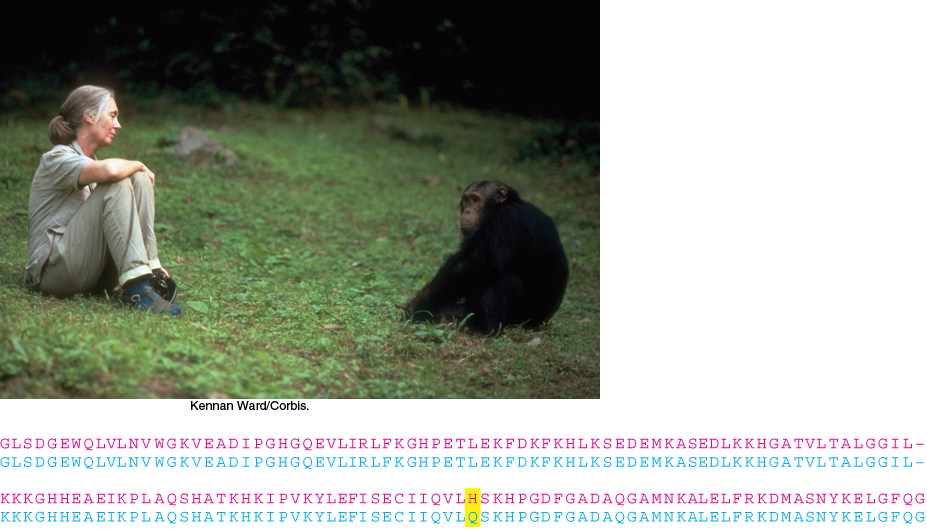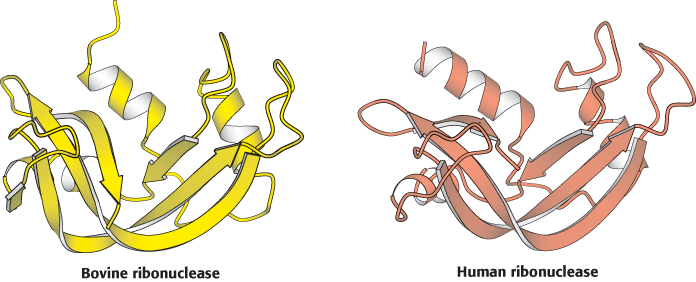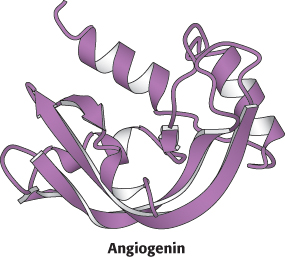Chapter Introduction
Exploring Evolution and Bioinformatics

Evolutionary relationships are manifest in protein sequences. The close kinship between human beings and chimpanzees, hinted at by the mutual interest shown by Jane Goodall and a chimpanzee in the photograph, is revealed in the amino acid sequences of myoglobin. The human sequence (red) differs from the chimpanzee sequence (blue) in only one amino acid in a protein chain of 153 residues.
[(Left) Kennan Ward/Corbis.]
OUTLINE
Homologs Are Descended from a Common Ancestor
Statistical Analysis of Sequence Alignments Can Detect Homology
Examination of Three-Dimensional Structure Enhances Our Understanding of Evolutionary Relationships
Evolutionary Trees Can Be Constructed on the Basis of Sequence Information
Modern Techniques Make the Experimental Exploration of Evolution Possible
Like members of a human family, members of molecular families often have features in common. Such family resemblance is most easily detected by comparing three-dimensional structure, the aspect of a molecule most closely linked to function. Consider as an example ribonuclease from cows, which was introduced in our consideration of protein folding (Section 2.6). Comparing structures reveals that the three-dimensional structure of this protein and that of a human ribonuclease are quite similar (Figure 6.1). Although the degree of overlap between these two structures is not unexpected, given their nearly identical biological functions, similarities revealed by other such comparisons are sometimes surprising. For example, angiogenin, a protein that stimulates the growth of new blood vessels, is also structurally similar to ribonuclease—so similar that both angiogenin and ribonuclease are clearly members of the same protein family (Figure 6.2). Angiogenin and ribonuclease must have had a common ancestor at some earlier stage of evolution.

Figure 6.1:  Structures of ribonucleases from cows and human beings. Structural similarity often follows functional similarity.
Structures of ribonucleases from cows and human beings. Structural similarity often follows functional similarity.
[Drawn from 8RAT.pdb. and 2RNF.pdb.]

Figure 6.2:  Structure of angiogenin. The protein angiogenin, identified on the basis of its ability to stimulate blood-vessel growth, is highly similar in three-dimensional structure to ribonuclease.
Structure of angiogenin. The protein angiogenin, identified on the basis of its ability to stimulate blood-vessel growth, is highly similar in three-dimensional structure to ribonuclease.
[Drawn from 2ANG.pdb.]
Three-dimensional structures have been determined for only a small proportion of the total number of proteins. In contrast, gene sequences and the corresponding amino acid sequences are available for a great number of proteins, largely owing to the tremendous power of DNA cloning and sequencing techniques, including applications to complete-genome sequencing (Chapter 5). Evolutionary relationships also are manifest in amino acid sequences. For example, 35% of the amino acids in corresponding positions are identical in the sequences of bovine ribonuclease and angiogenin. Is this level sufficiently high to ensure an evolutionary relationship? If not, what level is required? In this chapter, we shall examine the methods that are used to compare amino acid sequences and to deduce such evolutionary relationships.
Sequence-comparison methods are powerful tools in modern biochemistry. Sequence databases can be probed for matches to a newly elucidated sequence to identify related molecules. This information can often be a source of considerable insight into the function and mechanism of the newly sequenced molecule. When three-dimensional structures are available, they can be compared to confirm relationships suggested by sequence comparisons and to reveal others that are not readily detected at the level of sequence alone.
By examining the footprints present in modern protein sequences, the biochemist can learn about events in the evolutionary past. Sequence comparisons can often reveal pathways of evolutionary descent and estimated dates of specific evolutionary landmarks. This information can be used to construct evolutionary trees that trace the evolution of a particular protein or nucleic acid, in many cases from Archaea and Bacteria through Eukarya, including human beings. Molecular evolution can also be studied experimentally. In some cases, DNA from fossils can be amplified by PCR methods and sequenced, giving a direct view into the past. In addition, investigators can observe molecular evolution taking place in the laboratory, through experiments based on nucleic acid replication. The results of such studies are revealing more about how evolution proceeds.


 Structures of ribonucleases from cows and human beings. Structural similarity often follows functional similarity.
Structures of ribonucleases from cows and human beings. Structural similarity often follows functional similarity.

 Structure of angiogenin. The protein angiogenin, identified on the basis of its ability to stimulate blood-
Structure of angiogenin. The protein angiogenin, identified on the basis of its ability to stimulate blood-